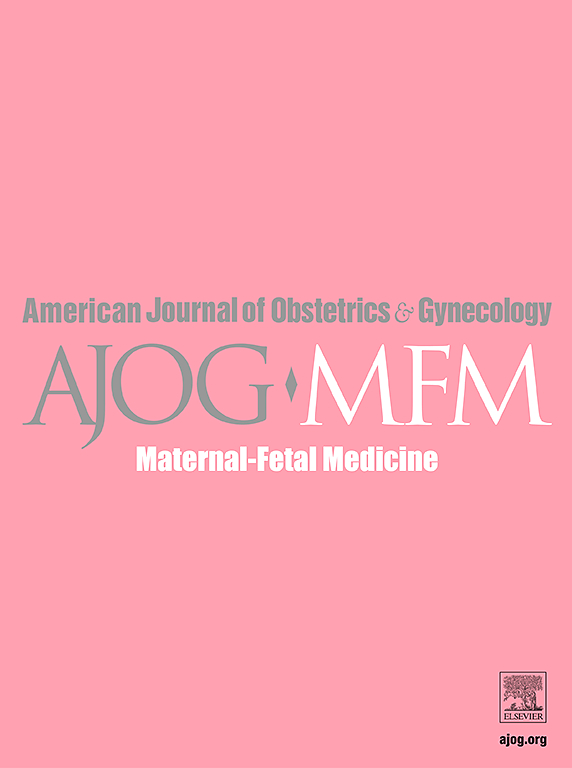环扎术和早产胎膜破裂后的结果:来自环扎术纵向评估和研究国际合作(IC-CLEAR)的数据。
IF 3.1
2区 医学
Q1 OBSTETRICS & GYNECOLOGY
American Journal of Obstetrics & Gynecology Mfm
Pub Date : 2025-08-11
DOI:10.1016/j.ajogmf.2025.101753
引用次数: 0
摘要
背景:文献是矛盾的关于管理宫颈环扎一旦患者经历早产胎膜破裂(PPROM)。由于PPROM术后产妇和新生儿感染发病率的风险,一些人建议切除环扎术,另一些人则主张保留环扎术,因为这有利于延迟分娩。目的:我们的研究目的是确定妊娠34周(w)前发生PPROM的妇女保留环带的安全性。研究设计:回顾性队列研究2016年6月至2020年6月在美国和哥伦比亚的8个地点进行的单胎妊娠结扎史、超声或体检指征的回顾性队列研究。主要关注的暴露时间是从PPROM到结扎切除(CR)的时间,分为早期< 48小时(h)或延迟(≥48小时)。作为数据库设计的一部分收集的产妇安全结局包括临床羊膜绒毛膜炎、组织学羊膜绒毛膜炎、产后子宫内膜炎、出血、败血症和重症监护病房入院。新生儿安全结局是脓毒症、早产并发症和死亡的综合结果。统计分析包括双变量和多变量技术。还比较了早期和延迟CR组之间PPROM和分娩之间的潜伏期。结果:839例采用环扎术的单胎妊娠中,135例(16.1%)在妊娠34周前发生PPROM,其中127例环扎术到位。37例因分娩、出血、绒毛膜羊膜炎或脐带脱垂而接受了立即CR,因此被排除在进一步的分析之外。89例患者纳入最终分析,其中早期CR 59例(66.3%),延迟CR 30例(33.7%)。临床绒毛膜羊膜炎和组织学绒毛膜羊膜炎的发生率在两组之间相似(临床:早期CR 22.0% vs延迟CR 40.0%, p=0.08;组织学:早期CR为55.1%,延迟CR为66.7%,p=0.30)。延迟CR组产后子宫内膜炎发生率高于早期CR组(16.7%比1.7%,p=0.008)。新生儿综合预后和新生儿死亡率在两组之间相似。PPROM到分娩的潜伏期较长,CR延迟7天(p结论:诊断为早产胎膜破裂后延迟取环术可增加产后子宫内膜炎发生率和延迟分娩1周,但新生儿发病率和死亡率未显著增加。本文章由计算机程序翻译,如有差异,请以英文原文为准。
Outcomes after cerclage and preterm prelabor rupture of membranes: data from the international collaborative for cerclage longitudinal evaluation and research (IC-CLEAR)
Background
The literature is conflicting regarding the management of cervical cerclage once patients experience preterm prelabor rupture of membranes (PPROM). While some recommend removal of the cerclage due to the risk of maternal and neonatal infectious morbidity after PPROM, others advocate retention of the cerclage due to the benefit of latency to delivery.
Objective
Our study objective is to determine the safety of cerclage retention in women who experience PPROM before 34 weeks (w) gestation.
Study Design
Retrospective cohort study of singleton pregnancies with cerclage for history, ultrasound or physical exam indications between June 2016 and June 2020 at 8 sites across United States and Colombia. The primary exposure of interest was the time from PPROM to cerclage removal (CR) categorized as early < 48 hours (h)– or delayed (≥48 h). Maternal safety outcomes collected as part of the database design included clinical chorioamnionitis, histologic chorioamnionitis, postpartum endometritis, hemorrhage, sepsis, and intensive care unit admission. Neonatal safety outcome was a composite of sepsis, prematurity complications and death. Statistical analysis included bivariate and multivariate techniques. Latency between PPROM and delivery was also compared between the early and delayed CR groups.
Results
Of 839 singleton pregnancies managed with cerclage, 135 (16.1%) experienced PPROM before 34 weeks gestation–127 with the cerclage in place. 37 underwent immediate CR for labor, bleeding, chorioamnionitis or cord prolapse and as such, were excluded from further analyses. Eighty-nine patients were included in final analysis–59 early CR (66.3%) and 30 delayed CR (33.7%). Rates of clinical chorioamnionitis and histologic chorioamnionitis were similar between groups (clinical: early CR 22.0% vs delayed CR 40.0%, P=.08; histologic: early CR 55.1% vs delayed CR 66.7%, P=.30). Postpartum endometritis rate was higher in delayed CR vs early CR (16.7% vs 1.7%, P=.008). Composite neonatal outcome and neonatal mortality were similar between groups. Latency from PPROM to delivery was longer with delayed CR by 7 days (P<.001). In adjusted analyses, clinical chorioamnionitis was not independently associated with cerclage removal timing when controlling for PPROM before 24 weeks (AOR 0.41 [95% CI 0.16, 1.07], P=.07) and endometritis was lower with early CR (AOR 0.09 [95% CI 0.01, 0.79], P=.03). We also evaluated the relationship between neonatal outcomes and cerclage removal timing controlling for corticosteroids and PPROM before 24 weeks and found that composite neonatal outcome was not independently associated with cerclage removal timing (AOR 0.36 [95% CI 0.07-1.91], P=.23). Neonatal mortality was lower with corticosteroid administration (AOR 0.15 [95% CI 0.02, 0.97], P=.046) and higher in PPROM before 24w (AOR 12.2 [95% CI 2.05, 72.7], P=.006).
Conclusion
Delaying cerclage removal in patients after a diagnosis of preterm prelabor rupture of membranes can increase the rate of postpartum endometritis and delay delivery by 1 week without significantly increasing the rate of neonatal morbidity and mortality.
求助全文
通过发布文献求助,成功后即可免费获取论文全文。
去求助
来源期刊

American Journal of Obstetrics & Gynecology Mfm
Medicine-Medicine (all)
CiteScore
7.40
自引率
3.20%
发文量
254
审稿时长
40 days
期刊介绍:
The American Journal of Obstetrics and Gynecology (AJOG) is a highly esteemed publication with two companion titles. One of these is the American Journal of Obstetrics and Gynecology Maternal-Fetal Medicine (AJOG MFM), which is dedicated to the latest research in the field of maternal-fetal medicine, specifically concerning high-risk pregnancies. The journal encompasses a wide range of topics, including:
Maternal Complications: It addresses significant studies that have the potential to change clinical practice regarding complications faced by pregnant women.
Fetal Complications: The journal covers prenatal diagnosis, ultrasound, and genetic issues related to the fetus, providing insights into the management and care of fetal health.
Prenatal Care: It discusses the best practices in prenatal care to ensure the health and well-being of both the mother and the unborn child.
Intrapartum Care: It provides guidance on the care provided during the childbirth process, which is critical for the safety of both mother and baby.
Postpartum Issues: The journal also tackles issues that arise after childbirth, focusing on the postpartum period and its implications for maternal health. AJOG MFM serves as a reliable forum for peer-reviewed research, with a preference for randomized trials and meta-analyses. The goal is to equip researchers and clinicians with the most current information and evidence-based strategies to effectively manage high-risk pregnancies and to provide the best possible care for mothers and their unborn children.
 求助内容:
求助内容: 应助结果提醒方式:
应助结果提醒方式:


